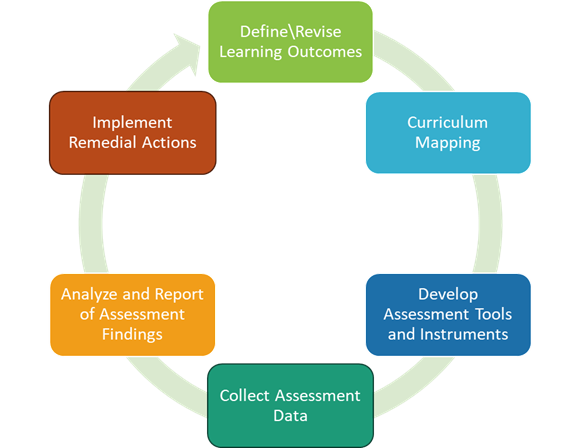Analyzing Assessment Data and Closing the Assessment Loop
Learning outcomes assessment (LOA) is one of the keystones of the educational process. It is not only essential for guiding the development of individual students, but also for monitoring and continuously improving the quality of teaching and learning. However, the success of the continuous improvement cycle depends heavily on how accurate and effective the assessment loop is closed. Closing the assessment loop requires that the collected assessment data is analyzed and the causes behind any discovered shortcoming are identified. Appropriate remedial actions are then developed, and their impact is measured and analyzed as shown below.

After collecting the student performance, the collected data should be aggregated to calculate the attainment result for each outcome. The attainment results are then analyzed by comparing the actual attainment level with the predetermined attainment targets. If the results suggest that students performed below expectations in one or more learning outcomes, the alignment matrices should be used to track down the used assessment methods for that learning outcome, and the associated topical outline. The aim of this analysis process is to determine where improvements should be introduced to improve the achievement level in the following assessment cycle.
The next step is to discuss the assessment finding with the course/program constituencies and determine the corrective actions to be implemented. For effective recovery, it is recommended to focus on the actions that will have the greatest potential on improving student learning. In other words, try to identify the improvements that do not require large amounts of resources but lead to significant increases in the quality of student learning. After deciding on the actions to be implemented, clearly articulate what is to be done, by whom, by when and how data will be collected to assess the impact. Make sure these actions are aimed directly at improving student learning. You should also consider the implications and consequences of the remedial action on department policies, curriculum, resources allocations, faculty effort, the students’ experience of the program, etc., and prioritize improvement actions based on high impact, low cost.
Do you find this content helpful?
عفوا
لايوجد محتوى عربي لهذه الصفحة
عفوا
يوجد مشكلة في الصفحة التي تحاول الوصول إليها

